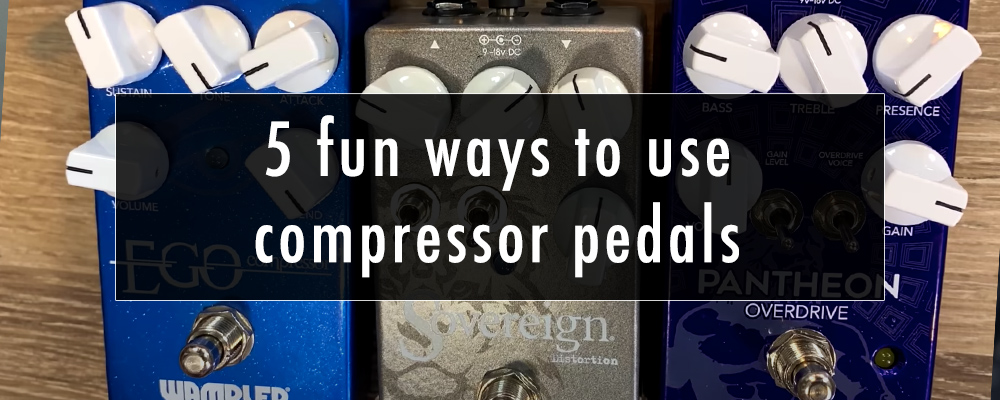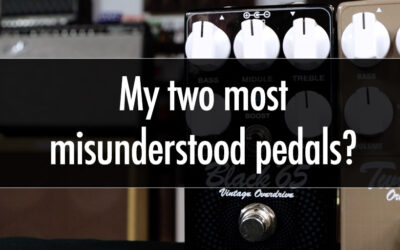
I love the compressor. I just do. It’s a really solid guitar pedal effect, and there are tons of different ways that you can use it. In this blog, I want to break down a few of my favorites.
A couple of these methods are fairly standard, but a few of the others? Not so much. My goal in this blog is to give you at least two or three new variations on this tried-and-tried effect that you haven’t used before.
Let’s jump right in.
Highlighting Your Chicken Picking With Compression
Let’s start with an old classic: the chicken-picking playing style. It’s a staple of ’90s country, but if it has to compete with a more distorted, dirty guitar or even just a bassist with a really good amp, then it can get lost in your mix. That’s where the compressor comes in.
In the past, a lot of people have used the compressor in this context as more of a limiter — which is sort of a po-ta-to, po-tah-to situation, since both methods compress the sound. The difference is that a limiter has a very high compression ratio. It’s super easy to achieve this: basically, crank the sustain all the way up and turn the blend all the way up.
Boom. You’re the new James Burton.
I rarely ever use this technique, but if you’re going for a traditional ’90s jam, then this is it.
Now, it’s important to understand that this method uses a ton of compression. You can hear the noise floor come up while everything gets squashed down, whereas a traditional compressor (more like a studio style) is really just a downward compressor that keeps the peaks down. This style of compression actually achieves this effect upwards and downwards. It brings those up lows, the really soft notes, and it takes the really loud notes and squashes them down. Basically, it eliminates the naturally occurring dynamics from your guitar, but it highlights the chicken picking, which is the goal.
If you do want to add back in a little of those dynamics, it’s an easy fix. With this style of compressor (the Wampler Ego parallel compressor works great here), just blend in some clean tone with it and back down a little bit is on the sustain. The resulting tone isn’t exactly chicken picking, but it still sounds great.
You also want to keep in mind that a lot of this type of tone depends on how you’re picking at the guitar. Whether or not you use compression, you need to pluck at those strings pretty dang hard to to be heard. Think of it as a test of strength/worthiness, like Thor picking up Mjolnir, and you’ll do just fine.
Using a Compressor With Single Coils / With Humbuckers
Another common technique is to use your compressor with a single coil pickup to fatten up the tone. Again, it’s super simple. Just add a little bit of compression and dial back on the sustain, then it adds just a little bit of fatness. Nothing too drastic. Think of it as 2% milk VS whole milk.
Now, this question always comes up: what happens if you use that sort of tone with a guitar with humbuckers? Does the humbuckers work the same with it?
If you watch the video below at around the 3:30 point, and you’ll see me try this out. Basically, I demoed this with a Whitfill guitar, which is kind of a mix between a Les Paul and a Telecaster. The humbuckers aren’t super hot in this guitar, but they are a lot like my Les Paul pickups. By adding in compression (turning the sustain up just a tad, and backing off the blend a little bit), you can definitely hear a difference. It squashes the sound more in the humbucker pickup than it would in the single coil pickup, because the strength of the signal from the humbucker is greater than a single coil.
Essentially, it’s going to act a lot like an input gain adjustment. You might have to back off the sustain a little bit and add a little bit more blend to it, just because it is going to be more squashed and it’s going to compress that transit each time. It’s not going to mess anything up or sound too radically different if you use a humbucker pickup instead of a single coil, but there are a few differences. Just keep that in mind, dial your controls back a little bit on the compression, and you’ll do just fine.
Using Dirt With Compression
Next tip: using dirt with compression. Basically, in this situation you’re compressing the note. If you run a compression before the distortion pedal, then the result is that you’re compressing the note and then you’re distorting that note. It sounds fairly obvious, but if you think about what the sound is doing, then you understand why it goes from being very transient with a lot of response to being clamped down then distorted.
It also helps explain why this effect clamps down on the sound and then distorts it, as opposed to straight up-distortion which compresses the signal differently.
The order makes all the difference. If you stack your pedals with distortion first and then compression, the guitar is just going to respond differently. The good news is that you can try it either way, and both setups are great.
If you run compression before that distortion, then you can hear that difference quite a bit. Even though the blend has quite a bit of clean signal into it, the sustain of that note really carries through. There’s a huge difference there. You’re going to notice something similar when the compression is stacked after the distortion, but the response is different. When you’re actually hitting the note, it just feels a little different to have that compression afterwards.
Cleaning Up the Slop With Compression
Great news: you can use a compressor to hide sloppy playing. Now, there’s guitar techniques that I’m awesome at, like the chicken picking, finger roll licks, stuff like that, but I’m really bad at straight-up shredding. It’s just not my thing, and it never has been.
Fortunately, my compressor does a pretty solid job of hiding that. If I’m about to hit that solo spot on some Def Leppard song, my distortion is on, and my mullet is blowing in the wind, I’ll just kick on my compression with the sustain up quite a bit (I also make sure I’ve backed way off that clean blend), and then I can let the sloppiness fly.
This is a great fallback if you’ve got to play some ’80s rock song with the shredding licks, and you need to do it cleanly (or at least pass for clean in front of the guitar players). Just kick on and compressor and go for it.
Using Compression After Delay / Reverb
Another great option is to put a compressor after any sort of delay or reverb. It really just gives sort of a different effect, a different tonality, all depending on how you have it set up.
It gives you the sound of more repeats or slightly louder compression, but either way it’s just the coolest feature. When I set this up on my compression pedal, I’ll have the sustain all the way up, the tone set at little past noon, and I have it way down on the blend. It’s important to get the balance right, because I don’t want it fully compressed so that it squashes everything, but I do want some of that warmth and just a little bit of that punch.
If I’m going after reverb instead of delay, there are a few subtle differences. It’s honestly a hard tone to describe, but whenever you hear it and whenever you play it, you get a sense of some extra air that’s around the echoes and around each echo independently. It’s a very odd effect, but it produces some beautiful sounds.
Using Compression to Control Volume
Okay, let’s look at one more technique, one that’s super practical: you can use compression as a limiting device to control the volumes throughout the chain.
In my demo, I just used two different pedals set at completely different levels. Now, normally that would cause a problem in the mix. If you’re playing with a band, the kick on one pedal might not be loud enough, or it might be too loud. The compressor fixes that problem. In this situation, I favor a Ross-style compression. Similar to the chicken-picking effect we looked at earlier (though not quite as dramatic), the compressor here works to bring up the quieter effect pedal and compress the tone of the louder pedal, and basically evens out everything in the mix.
If you want, you can blend some of that clean signal back in with a parallel compression, because the compression is squashing things quite a bit. To achieve that, I would start with my blend all the way off, and then just add it back in until I can hear that I’m not losing those levels, but I am allowing the ability to level out the different effects.
I hope this helped you figure out a few new ways to use your compressor. I’d love to hear some feedback, so please make sure you comment below and let me know some specific examples of how you like to use compression. I’d love to read your comments!



Great article and ideas, Brian. I’ve always used compression for something basically simple. With my guitar at full gain, the compressor allows me to back the volume control down to two or three, and allow the cleaner sound to be nearly the same volume level as full gain, making stage performance easier. It’s an easy way to eliminate constant foot switching switching on and off clean and gain, and keep the focus on performance.
very helpful. I liked the extensive use of the Ego. Thank you!
Great article Brian!
How about using the compressor as a volume boost? How can I achieve a volume boost with the compressor ?
Usually compressors will have some kind of make-up gain to compensate for the level drop from the compression, but you can turn that up even more than the compressor turns it down if you’d like to use it for a bit more boost as well.
Cheers.
Awesome article, Brian!! Please keep them coming.
Here’s my view a compressor is the most underrated player pedal out there. If you need to sound like demon you need one . Let me also say the EGO is hands down the best pedal I have ever bought to enhance my sound .
Sorry, I just saw this. What I’m thinking is using a multiband compressor with a clean blend in the FX loop, before a tremolo (obviously) and delay but after the two-channel preamp. The dirt channel has a boost. Guitar would be clean going into the amp. Noise worries are the primary consideration. I’m thinking the dirt with boost might come across as punchier. My primary guitar also has active pups. Any thoughts (especially about the noise thing)?